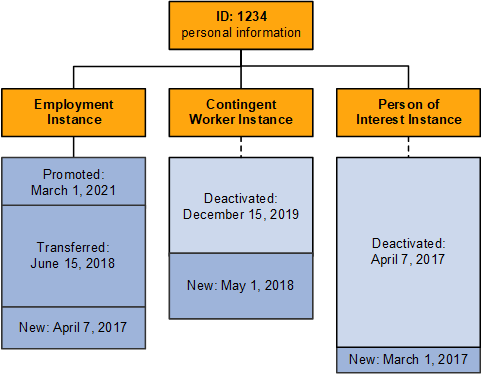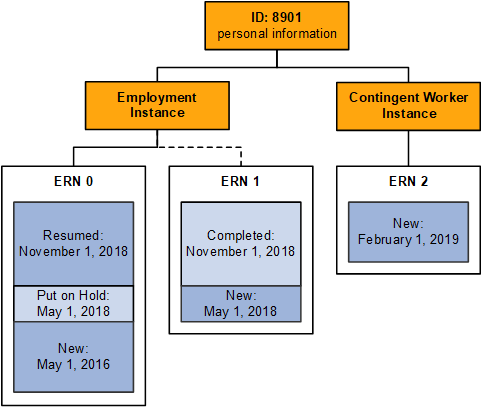Organizational Instances
An organizational instance is a single occurrence of an organizational relationship. After you create a personal information record for a person, create an organizational instance to enter and maintain job records. An organizational instance has its own hire date and contains the accumulation of the person's job data records that are associated with that instance.
Use one of the following components to create an organizational instance:
|
Classic Components |
Fluid Components |
|---|---|
|
|
Note: Hire applicants with data that is in the system by using the Hire component (ER_APP_HIRE_LAUNCH) in PeopleSoft Talent Acquisition Manager.
See Hiring Applicants.
Update and maintain job data for the instances using the following components:
|
Classic Pages |
Fluid Pages |
|---|---|
|
Manage Job Tile (JOB_DATA_FL component) |
Organizational Instances for People of Interest
PeopleSoft delivers a number of different POI types that you can activate and use as needed. The following types require job records:
COBRA qualified beneficiaries.
Pension Payees.
Stock - board members.
Stock - non-HR employees.
Global Payroll payees.
Student refunds.
Some of the POIs you may want to track will not require a job record. If you are tracking POIs without jobs, you will need to use the Add a Person of Interest component (PERS_POI_ADD) in classic or (Fluid) Maintain Person of Interest Tile (PERS_POI_MAINT_FL) in fluid to indicate what kind of POI relationship the person has, as well as to enter any necessary security parameters to control access to the person's data.
Example: A Person with Three Organizational Instances
Mario Estevez needs to successfully complete training with a third-party vendor before starting his new position. To reimburse Mario for the cost of the training, he needs a job record. The human resources administrator adds him in the system by using the Add a Person component and assigns him the ID 1234. The administrator then creates a POI job record for him by using the Add Person of Interest Job component.
After Mario completes his training, he joins the company as an employee. The human resources administrator terminates his POI instance (by using the Job Data component) and creates an employment instance by using the Add Employment Instance component.
A little more than a year after joining the company, Mario is given the opportunity to participate in a short-term project. The human resources administrator creates a contingent worker instance for him on the Add Contingent Worker Instance component.
Mario is later transferred and promoted in his employee job, and a new job data row is inserted for each of these changes. The historical job records accumulate under the organizational instance in which they are created. The human resources administrator updates the job records for the employment and contingent worker instances by using the Job Data component.
This table lists the changes to Mario's job records over a four-year period:
|
Action Date |
Employment Instance |
Contingent Worker Instance |
POI Instance |
|---|---|---|---|
|
March 1, 2017 |
POI instance created. |
||
|
April 7, 2017 |
Employment instance created with this date as the hire date. |
POI instance job record deactivated. |
|
|
May 1, 2018 |
No change to employment job record. |
Contingent worker instance created with this as the hire date. |
|
|
June 15, 2018 |
Transferred departments |
No change to the contingent worker job record. |
|
|
December 15, 2019 |
No change to employment job record. |
Contingent worker job ends and the job data record is deactivated. This date is the termination date for this instance. |
|
|
March 1, 2021 |
Promoted. |
This diagram illustrates how the system stores Mario's data: under the person record, there are separate employee, contingent worker, and POI organizational instances, each with its own event history:

Employment record numbers (ERNs), in combination with a person's ID, uniquely identify a person's job data records. The system distinguishes between a person's organizational instances by using a new ERN when you create a new instance.
The system also creates a new ERN when you create a job data record in the following circumstances:
|
Action |
Comments |
|---|---|
|
Create concurrent jobs, including:
|
Note: Additional organizational instances are identified as hires on human resources reports and additional assignments are not. Use this distinction to guide how you enter additional jobs in the system. If you do not need to distinguish between concurrent jobs, choose one method of entering concurrent jobs and use it consistently. See (Classic) Adding Organizational Instances. |
|
Create a global assignment (employees only). |
Use the Home/Host Information component (HOME_HOST_DATA) to create a global assignment job record. The system gives the global assignment (host) job record a new employment record number to distinguish it from the employee's original (home) job record. |
|
Create a temporary assignment, including Japanese intercompany transfer (shukkou). |
When you assign a worker to a temporary assignment on the Job Data component, the system suspends the substantive job and identifies the temporary job record with a new employment record number. |
Example: A Person with Multiple ERNs
Jan Smith is hired to work in the sales division of Sutter Enterprises. After two years of outstanding performance, she starts a six-month temporary assignment in a subsidiary company to assist with the launch of a new application. At the end of the assignment she returns to her original job, but three months later she takes on a consulting role at the subsidiary in addition to her sales job. This table lists the changes to Jan's job records over the three-year period:
|
Action Date |
Employment Instance |
Contingent Worker Instance |
|---|---|---|
|
May 1, 2016 |
Employment instance created. Job record identified by:
|
|
|
May 1, 2018 |
Substantive job suspended. |
|
|
May 1, 2018 |
New job record for temporary assignment created. Job record identified by:
|
|
|
November 1, 2018 |
Temporary assignment completed. |
|
|
November 1, 2018 |
Substantive job resumed. |
|
|
February 1, 2019 |
No change to employment job record. |
Contingent worker instance created. Job record identified by:
|
This diagram illustrates Jan Smith's job records under the organizational relationships. Under the person record, there are separate employee and contingent worker organizational instances. There are two ERNs under the employment instance and one ERN under the contingent worker instance. Each ERN has its own event history:
